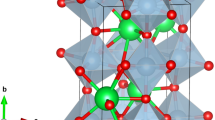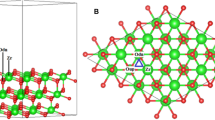Abstract
Under the water-rich pre-treatment and/or reaction conditions, structure and chemistry of the monoclinic zirconia surfaces are strongly influenced by oxygen vacancies and incorporated water. Here, we report a combined first-principles and atomistic thermodynamics study on the structure and stability of selected surfaces of the monoclinic zirconia. Our results indicate that among the studied surfaces, the most stable (\({\overline{1}}11\)) surface is the least vulnerable towards oxygen vacancies in contrast to the less stable (011) and (\({\overline{1}}01\)) surfaces, where formation of oxygen vacancies is energetically more favorable. Furthermore, we present a vigorous, systematic screening of water incorporation onto the studied surfaces. We observe that the greatest stabilization of the surfaces is achieved when a part of the adsorbed water molecules is dissociated. Nevertheless, the importance of water dissociation for achieving the greatest stabilization is high for the less stable (011) and (\({\overline{1}}01\)) surfaces, while completely hydrated (\({\overline{1}}11\)) surface is stabilized equally regardless of the water dissociation state. Analysis of the constructed phase diagrams reveals that the (\({\overline{1}}11\)) surface remains preferably clean and the (011) and (\({\overline{1}}01\)) surfaces have dissociated water at low coverage under the reactive conditions of \(T = 600\)–900 K and \(p({\mathrm {H}}_{2}{\mathrm {O}}) < 1\) bar. Upon temperature decrease and/or pressure increase, all studied surfaces gradually uptake water until fully hydrated. All in all, our findings complement and broaden the existing picture of the structure and stability of the monoclinic zirconia surfaces under the pre-treatment and/or reaction conditions, enabling rationalization of the potential roles of zirconia as a heterogeneous support and a catalyst component.







Similar content being viewed by others
References
NIST-JANAF thermochemical tables (2013) http://kinetics.nist.gov/janaf/. Accessed 25 May 2016
Chauke HR, Murovhi P, Ngoepe PE, de Leeuw NH, Grau-Crespo R (2010) Electronic structure and redox properties of the Ti-doped zirconia (111) surface. J Phys Chem C 114:15403–15409. doi:10.1021/jp103181q
Chen HT, Chang JG (2010) Oxygen vacancy formation and migration in Ce\(_{1-x}\)Zr\(_{x}\)O\(_{2}\) catalyst: a DFT+U calculation. J Chem Phys 132(214):702. doi:10.1063/1.3429314
Contreras JL, Salmones J, Colín-Luna JA, Nuño L, Quintana B, Córdova I, Zeifert B, Tapia C, Fuentes GA (2014) Catalysts for H\(_{2}\) production using the ethanol steam reforming (a review). Int J Hydrog Energy 39:18835–18853. doi:10.1016/j.ijhydene.2014.08.072
Ding H, Virkar AV, Liu F (2012) Defect configuration and phase stability of cubic versus tetragonal yttria-stabilized zirconia. Solid State Ion 215:16–23. doi:10.1016/j.ssi.2012.03.014
Enkovaara J, Rostgaard C, Mortensen JJ, Chen J, Dułak M, Ferrighi L, Gavnholt J, Glinsvad C, Haikola V, Hansen HA, Kristoffersen HH, Kuisma M, Larsen AH, Lehtovaara L, Ljungberg M, Lopez-Acevedo O, Moses PG, Ojanen J, Olsen T, Petzold V, Romero NA, Stausholm-Møller J, Strange M, Tritsaris GA, Vanin M, Walter M, Hammer B, Häkkinen H, Madsen GKH, Nieminen RM, Nørskov JK, Puska M, Rantala TT, Schiøtz J, Thygesen KS, Jacobsen KW (2010) Electronic structure calculations with GPAW: a real-space implementation of the projector augmented-wave method. J Phys Condens Matter 22(253):202. doi:10.1088/0953-8984/22/25/253202
Foster AS, Sulimov VB, Gejo FL, Shluger AL, Nieminen RM (2001) Structure and electrical levels of point defects in monoclinic zirconia. Phys Rev B 64(224):108. doi:10.1103/PhysRevB.64.224108
Ganduglia-Pirovano MV, Hofmann A, Sauer J (2007) Oxygen vacancies in transition metal and rare earth oxides: current state of understanding and remaining challenges. Surf Sci Rep 62:219–270. doi:10.1016/j.surfrep.2007.03.002
Graf PO, Mojet BL, van Ommen JG, Lefferts L (2007) Comparative study of steam reforming of methane, ethane and ethylene on Pt, Rh and Pd supported on yttrium-stabilized zirconia. Appl Catal A 332:310–317. doi:10.1016/j.apcata.2007.08.032
Graf PO, Mojet BL, Lefferts L (2008) Influence of potassium on the competition between methane and ethane in steam reforming over Pt supported on yttrium-stabilized zirconia. Appl Catal A 346:90–95. doi:10.1016/j.apcata.2008.05.010
Han Y, Zhu J (2013) Surface science studies on the zirconia-based model catalysts. Top Catal 56:1525–1541. doi:10.1007/s11244-013-0156-5
Harju H, Lehtonen J, Lefferts L (2015) Steam- and autothermal-reforming of \(n\)-butanol over Rh/ZrO\(_{2}\) catalyst. Catal Today 244:47–57. doi:10.1016/j.cattod.2014.08.013
Harju H, Lehtonen J, Lefferts L (2016) Steam reforming of \(n\)-butanol over Rh/ZrO\(_{2}\) catalyst: role of 1-butene and butyraldehyde. Appl Catal B 182:33–46. doi:10.1016/j.apcatb.2015.09.009
Hoang TMC, Rao NK, Lefferts L, Seshan K (2015) Investigation of Ce–Zr oxide-supported Ni catalysts in the steam reforming of meta-cresol as a model component for bio-derived tar. ChemCatChem 7:468–478. doi:10.1002/cctc.201402857
Ignatchenko A, Nealon DG, Dushane R, Humphries K (2006) Interaction of water with titania and zirconia surfaces. J Mol Catal A 256:57–74. doi:10.1016/j.molcata.2006.04.031
Ignatchenko AV (2011) Density functional theory study of carboxylic acids adsorption and enolization on monoclinic zirconia surfaces. J Phys Chem C 115:16012–16018. doi:10.1021/jp203381h
Jiang N, Burri A, Park SE (2016) Ethylbenzene to styrene over ZrO\(_{2}\)-based mixed metal oxide catalysts with CO\(_{2}\) as soft oxidant. Chin J Catal 37:3–15. doi:10.1016/S1872-2067(15)60901-9
Jomard G, Petit T, Pasturel A, Magaud L, Kresse G, Hafner J (1999) First-principles calculations to describe zirconia pseudopolymorphs. Phys Rev B 59:4044–4052. doi:10.1103/PhysRevB.59.4044
Korhonen ST, Catalayud M, Krause AOI (2008) Stability of hydroxylated (\({\overline{1}}11\)) and (\({\overline{1}}01\)) surfaces of monoclinic zirconia: a combined study by DFT and infrared spectroscopy. J Phys Chem C 112:6469–6476. doi:10.1021/jp8008546
Kouva S, Andersin J, Honkala K, Lehtonen J, Lefferts L, Kanervo J (2014) Water and carbon oxides on monoclinic zirconia: experimental and computational insights. Phys Chem Chem Phys 16:20650–20664. doi:10.1039/c4cp02742f
Kouva S, Honkala K, Lefferts L, Kanervo J (2015) Review: monoclinic zirconia, its surface sites and their interaction with carbon monoxide. Catal Sci Technol 5:3473–3490. doi:10.1039/C5CY00330J
Liu T, Zhang X, Yuan L, Yu J (2015) A review of high-temperature electrochemical sensors based on stabilized zirconia. Solid State Ion 283:91–102. doi:10.1016/j.ssi.2015.10.012
McCullough JD, Trueblood KN (1959) The crystal structure of baddeleyite (monoclinic ZrO\(_{2}\)). Acta Crystallogr 12:507–511. doi:10.1107/S0365110X59001530
Mortensen JJ, Hansen LB, Jacobsen KW (2005) Real-space grid implementation of the projector augmented wave method. Phys Rev B 71(035):109. doi:10.1103/PhysRevB.71.035109
Nahar G, Duport V (2014) Hydrogen production from simple alkanes and oxygenated hydrocarbons over ceria–zirconia supported catalysts: review. Renew Sustain Energy Rev 32:777–796. doi:10.1016/j.rser.2013.12.040
Pacchioni G (2014) Ketonization of carboxylic acids in biomass conversion over TiO\(_{2}\) and ZrO\(_{2}\) surfaces: a DFT perspective. ACS Catal 4:2874–2888. doi:10.1021/cs500791w
Perdew JP, Burke K, Ernzerhof M (1996) Generalized gradient approximation made simple. Phys Rev Lett 77:3865–3868. doi:10.1103/PhysRevLett.77.3865
Perdew JP, Burke K, Ernzerhof M (1997) Generalized gradient approximation made simple [Phys. Rev. Lett. 77, 3865 (1996)]. Phys Rev Lett 78:1396–1396. doi:10.1103/PhysRevLett.78.1396
Pintos DG, Juan A, Irigoyen B (2012) Oxygen vacancy formation on the Ni/Ce\(_{0.75}\)Zr\(_{0.25}\)O\(_2\) (111) surface. A DFT+U study. Int J Hydrog Energy 37:14937–14944. doi:10.1016/j.ijhydene.2011.12.079
Piskorz W, Grybos J, Zasada F, Cristol S, Paul JF, Adamski A, Sojka Z (2011) Periodic DFT and atomistic thermodynamic modeling of the surface hydration equilibria and morphology of monoclinic ZrO\(_{2}\) nanocrystals. J Phys Chem C 115:24274–24286
Piskorz W, Grybos J, Zasada F, Zapala P, Cristol S, Paul JF, Sojka Z (2012) Periodic DFT study of the tetragonal ZrO\(_{2}\) nanocrystals: equilibrium morphology modeling and atomistic surface hydration thermodynamics. J Phys Chem C 116:19307–19320. doi:10.1021/jp3050059
Prakash BS, Kumar SS, Aruna ST (2014) Properties and development of Ni/YSZ as an anode material in solid oxide fuel cell: a review. Renew Sustain Energy Rev 36:149–179. doi:10.1016/j.rser.2014.04.043
Raz S, Sasaki K, Maier J, Riess I (2001) Characterization of adsorbed water layers on Y\(_{2}\)O\(_{3}\)-doped ZrO\(_{2}\). Solid State Ion 143:181–204. doi:10.1016/S0167-2738(01)00826-8
Reuter K, Scheffler M (2001) Surface core-level shifts at an oxygen-rich Ru surface: O/Ru(0001) vs. RuO\(_{2}\) (110). Surf Sci 490:20–28. doi:10.1016/S0039-6028(01)01214-6
Reuter K, Scheffler M (2002) Composition, structure, and stability of RuO\(_{2}\) (110) as a function of oxygen pressure. Phys Rev B 65(035):406. doi:10.1103/PhysRevB.65.035406
Reuter K, Scheffler M (2003) First-principles atomistic thermodynamics for oxidation catalysis: surface phase diagrams and catalytically interesting regions. Phys Rev B 90(046):103. doi:10.1103/PhysRevLett.90.046103
Rioche C, Kulkarni S, Meunier FC, Breen JP, Burch R (2005) Steam reforming of model compounds and fast pyrolysis bio-oil on supported noble metal catalysts. Appl Catal B 61:130–139. doi:10.1016/j.apcatb.2005.04.015
Robertson J (2004) High dielectric constant oxides. Eur Phys J Appl Phys 28:265–291. doi:10.1051/epjap:2004206
Sangalli D, Lamperti A, Cianci E, Ciprian R, Perego M, Debernardi A (2013) Role of oxygen vacancies on the structure and density of states of iron-doped zirconia. Phys Rev B 87(085):206. doi:10.1103/PhysRevB.87.085206
Syzgantseva OA, Calatayud M, Minot C (2012) Revealing the surface reactivity of zirconia by periodic DFT calculations. J Phys Chem C 116:6636–6644. doi:10.1021/jp209898q
Wang H, Li G, Xue Y, Li L (2007) Hydrated surface structure and its impacts on the stabilization of \(t\)-ZrO\(_{2}\). J Solid State Chem 180:2790–2797. doi:10.1016/j.jssc.2007.08.015
Yashima M, Hirose T, Katano S, Suzuki Y, Kakihana M, Yoshimura M (1995) Structural changes of ZrO\(_{2}\)–CeO\(_{2}\) solid solutions around the monoclinic–tetragonal phase boundary. Phys Rev B 51:8018–8025. doi:10.1103/PhysRevB.51.8018
Youssef M, Yildiz B (2012) Intrinsic point-defect equilibria in tetragonal ZrO\(_{2}{\text{: }}\) density functional theory analysis with finite-temperature effects. Phys Rev B 86(114):109. doi:10.1103/PhysRevB.86.144109
Zhu J, van Ommen JG, Lefferts L (2006) Effect of surface OH groups on catalytic performance of yttrium-stabilized ZrO\(_{2}\) in partial oxidation of CH\(_{4}\) to syngas. Catal Today 117:163–167. doi:10.1016/j.cattod.2006.05.046
Acknowledgments
We gratefully acknowledge the financial support from the Academy of Finland (Grant 277222). Electronic structure calculations were made possible through the use of computational resources provided by the CSC-IT Center for Science in Espoo, Finland (http://www.csc.fi/). We thank Dr. Jaana Kanervo and Prof. Leon Lefferts for fruitful discussions.
Author information
Authors and Affiliations
Corresponding author
Electronic supplementary material
Below is the link to the electronic supplementary material.
Rights and permissions
About this article
Cite this article
Bazhenov, A.S., Honkala, K. Understanding Structure and Stability of Monoclinic Zirconia Surfaces from First-Principles Calculations. Top Catal 60, 382–391 (2017). https://doi.org/10.1007/s11244-016-0701-0
Published:
Issue Date:
DOI: https://doi.org/10.1007/s11244-016-0701-0




